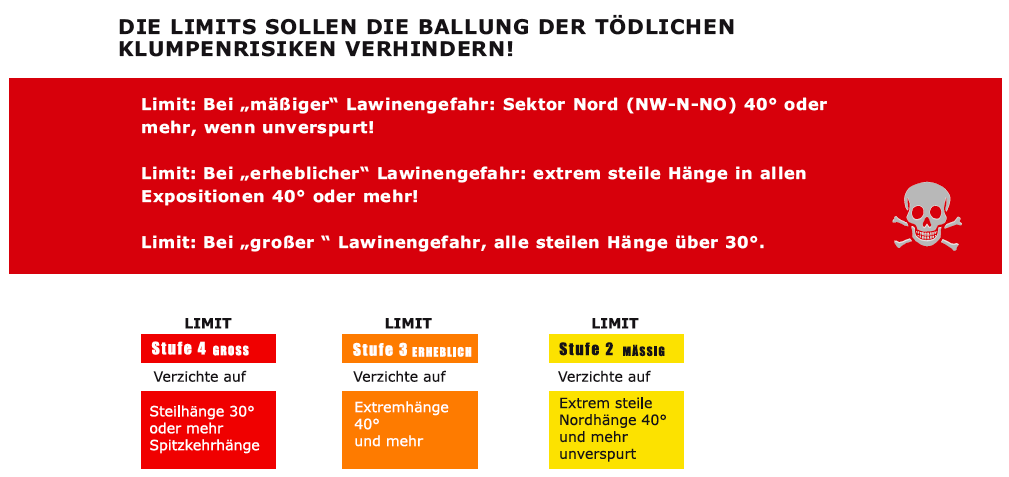Nine avalanche deaths in the Jamtal", "12 dead winter sports enthusiasts on the Kitzsteinhorn", "Craig Kelly dies in avalanche" these were the headlines last winter.
What did these terrible accidents have in common? None of those involved were ignorant Northern Lights greenhorns, but experienced alpinists, freeriders or mountain guides.
The avalanches don't care about the knowledge of their victims: even experts die in avalanches!
1. all avalanche accidents are recorded statistically. For example, slope inclination, slope exposure and the avalanche warning level prevailing at the time of the accident are evaluated.
2. It has been shown that there are factors (e.g. steepness, slope direction, etc.) that reinforce each other when they occur together. The avalanche expert Werner Munter speaks of "cluster risk" (accumulated risk). This means that when certain risk factors occur together, the risk of an avalanche accident increases dramatically!

For example, the combination of "shaded slope" (northern exposure), "very steep" and "rarely used" is particularly treacherous. In order to avoid the worst avalanche accidents in the future, the slope gradient of 39° must be the absolute upper limit for such slopes in the case of "moderate" avalanche danger (level 2). And that is the risk threshold: the limit!
The strategy to prevent a catastrophe is to stick to a risk upper limit (limit) and never exceed it, even in white-out conditions! Sounds logical and simple. And that's exactly what it is!
The risk spiral
Every freerider knows the (risky) spiral of the "White Rush"! You're finally in the mountains and completely stoked by the sight of countless powder-covered slopes. Every slope could be the best, but there is also a small risk that any one of these runswill be your last! But once you get going and only have powder on the brain, every run is better than the next and the next one is supposed to be the very best. Many riders push each other in the "competition" for the best lines. "That'll be fine...!" is what you hear experienced freeriders say at such moments. This is exactly when the powder rush has beaten reason! In such situations "many riders forget" the risk and of course the risk check with the reduction method or similar. But: Even if you have forgotten all the warnings, never exceed the limit. It is the upper limit, without exception! In case of "moderate" avalanche danger (level 2):
Do not ski steeper than 39° on rarely used shaded slopes (exposures NW-N-NE)! In case of "considerable" avalanche danger (level 3):
Do not ski steeper than 39° in all exposures!
This restriction does not apply to constantly used variant descents near the piste. However, the descents must be directly accessible from the last lift, without further ascent or long traversing. Caution: There is often an avalanche risk here too.
PowderGuide tip
39° is the (reasonable) limit for off-piste descents on shaded slopes (NW-NE exposures)! For slopes with other exposures: Check your risk and decide for yourself! But remember: many accidents happen here too! Therefore: Less can be more!
In case of "high" avalanche danger (level 4):
Stay below 30° in all exposures in moderately steep terrain. Caution: Avalanches can penetrate very far into flat terrain.
3x3 filter, reduction method and limit strategy are intended for risk-conscious freeriders who enjoy risk management and want to get through the winter safely. It is by no means a free ticket for adrenaline and extreme freaks. No method can guarantee you 100% safety! Only you can decide for yourself how much risk you want to take.





